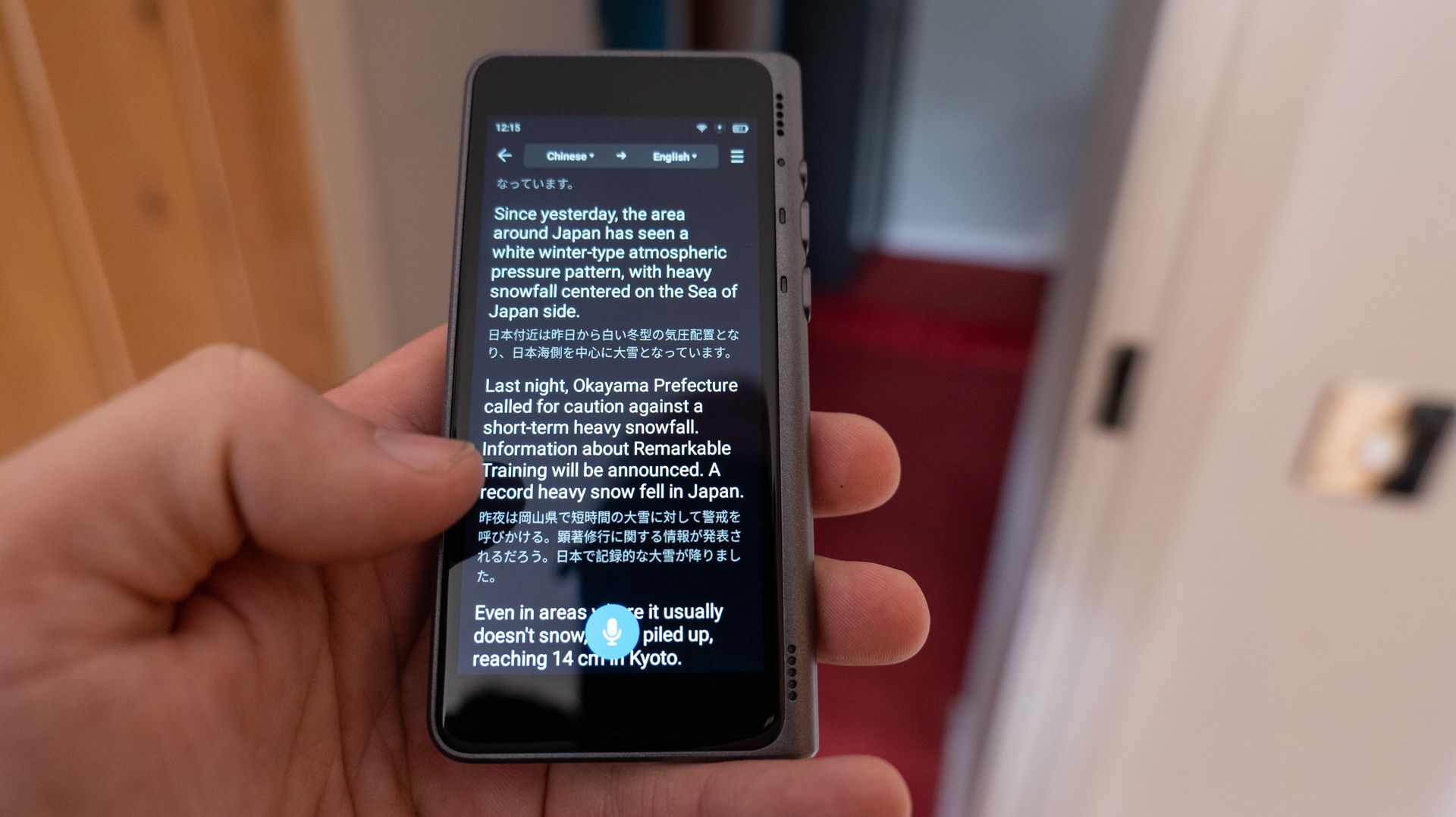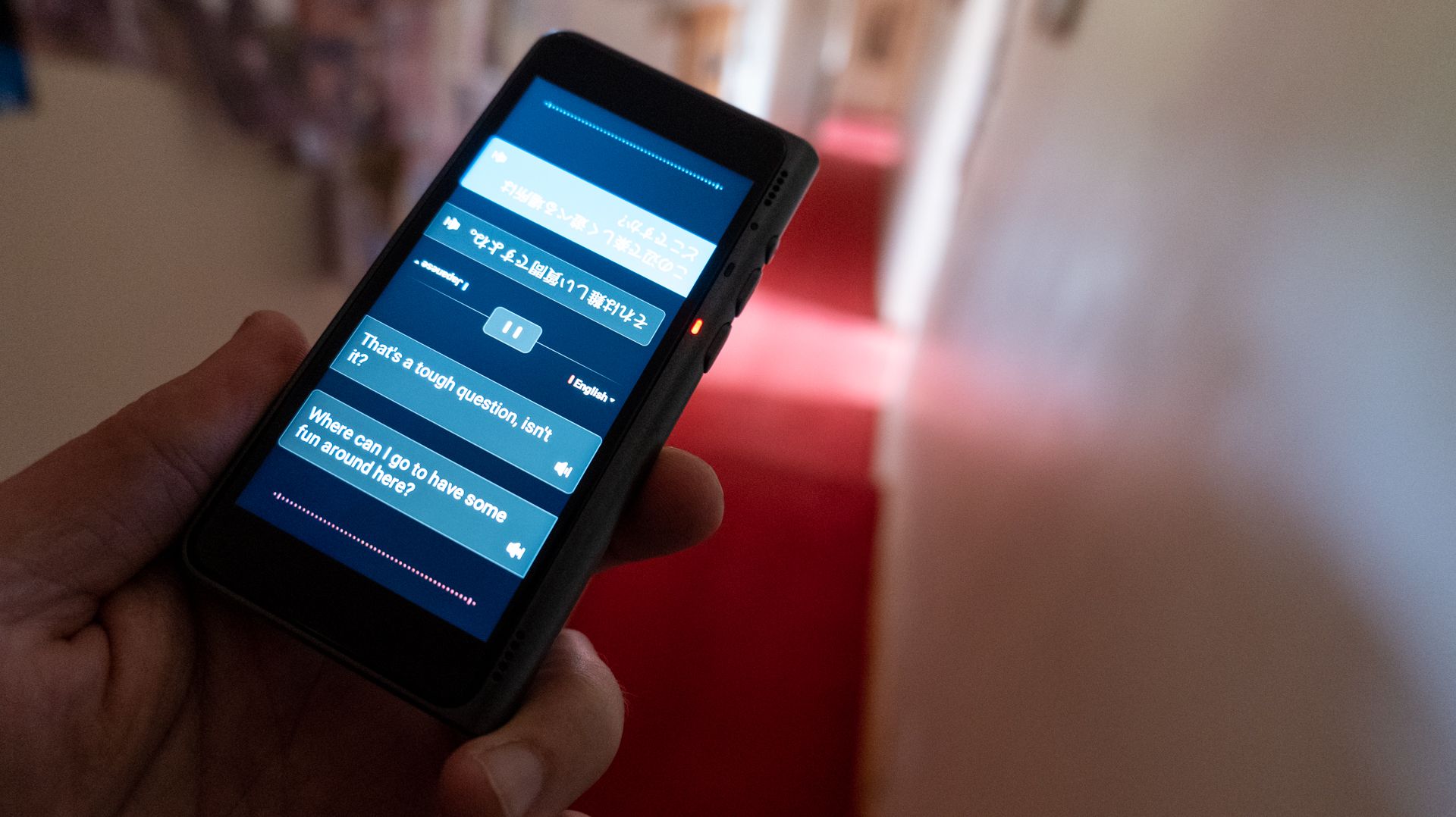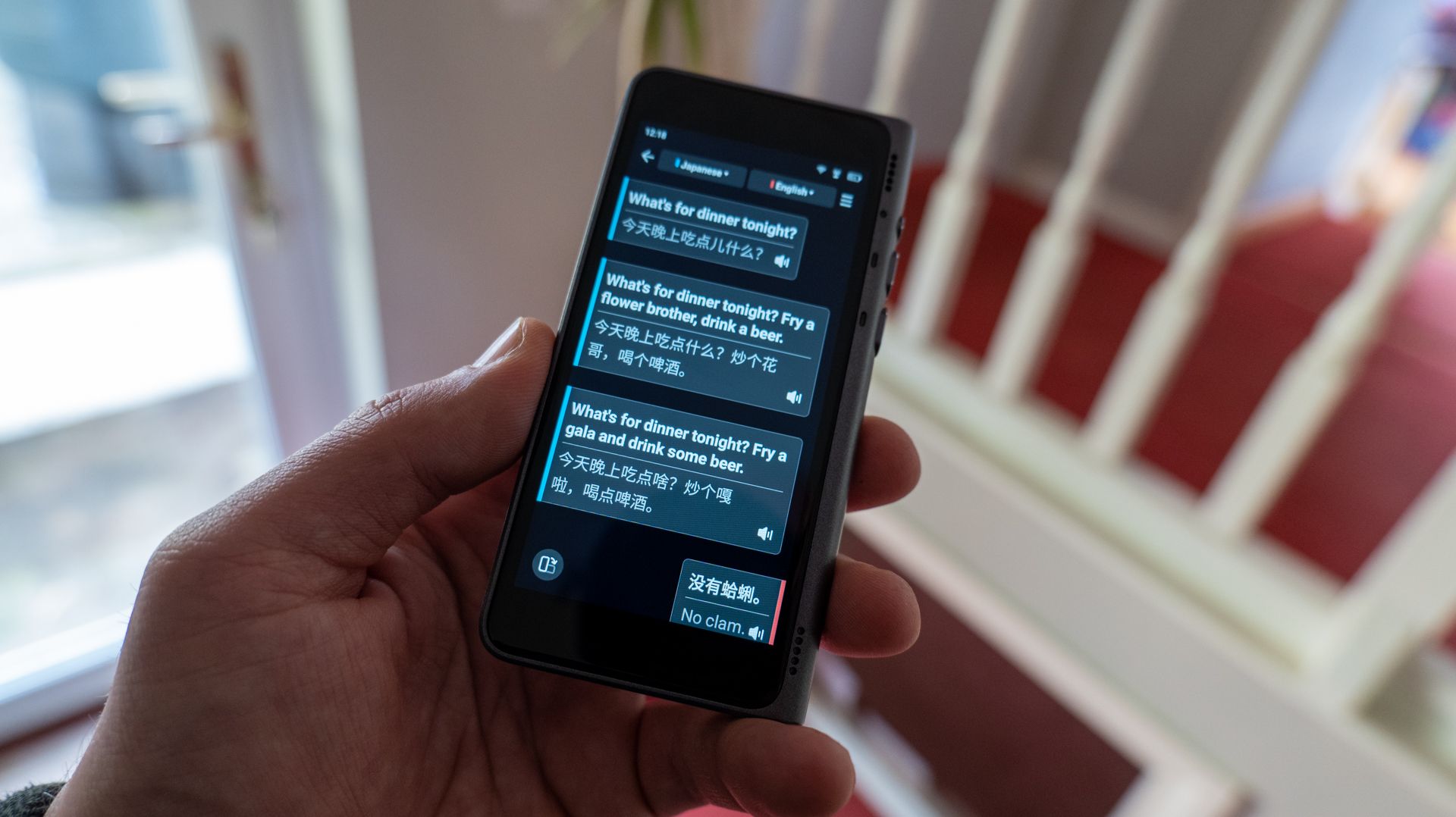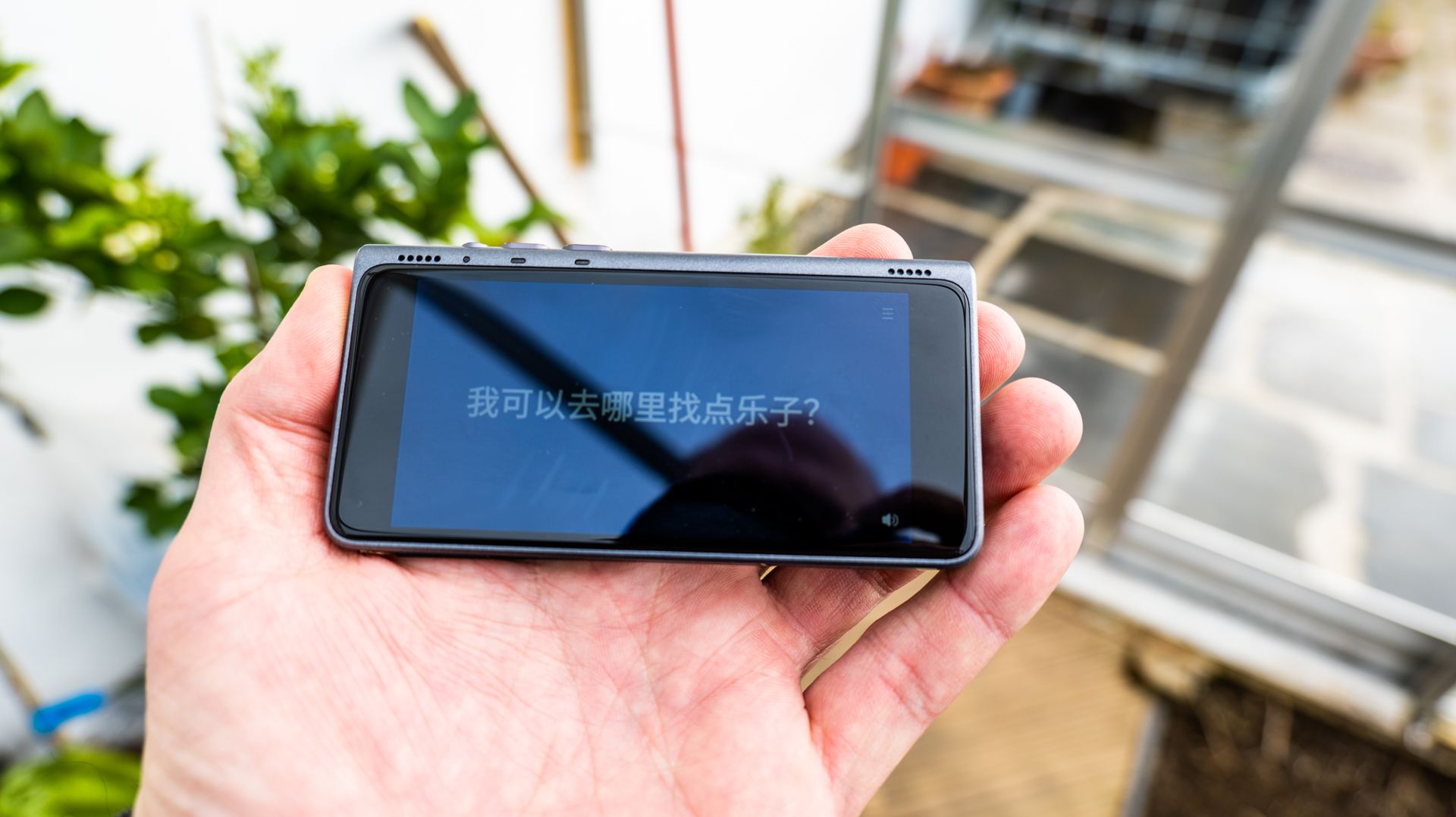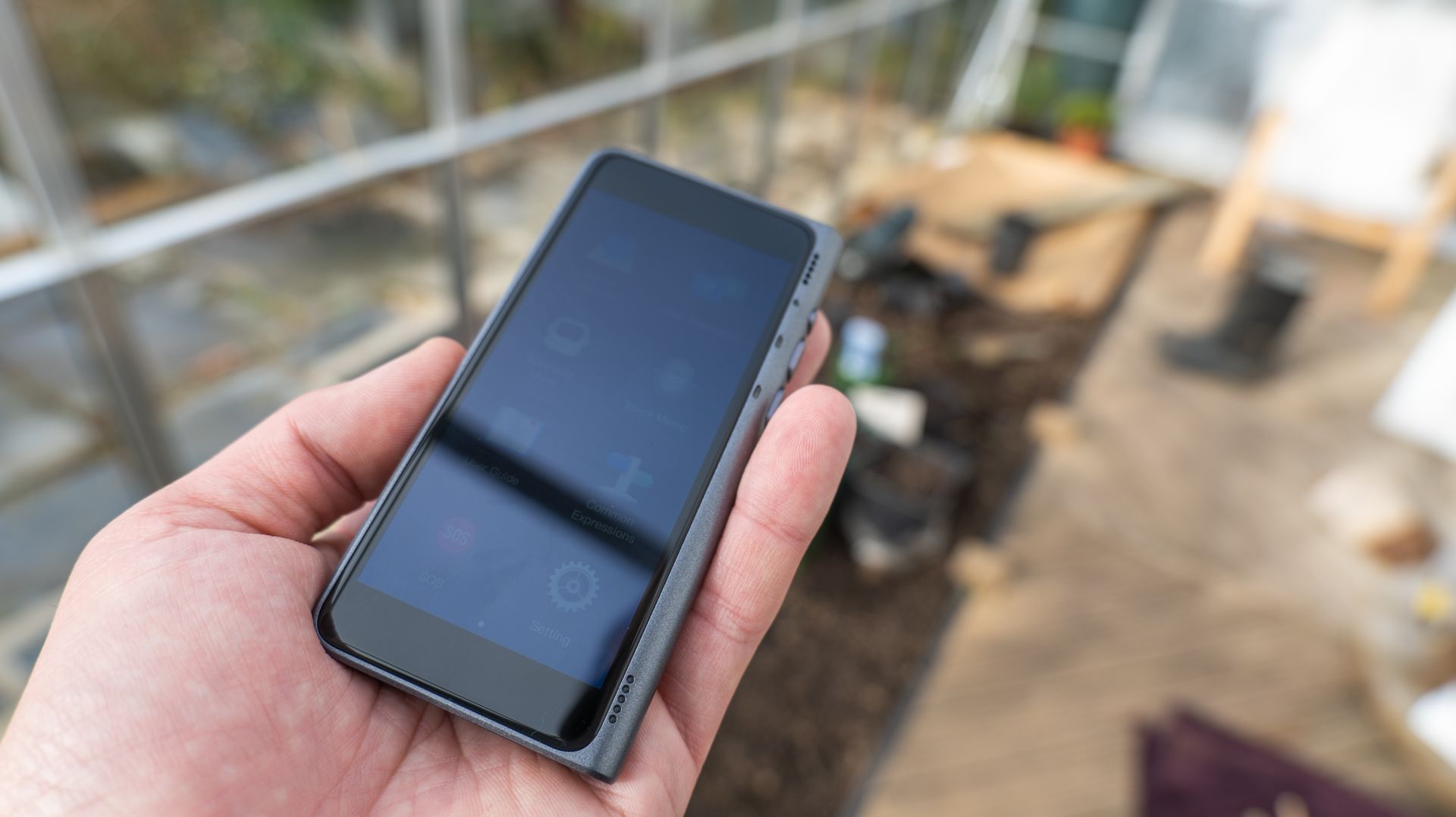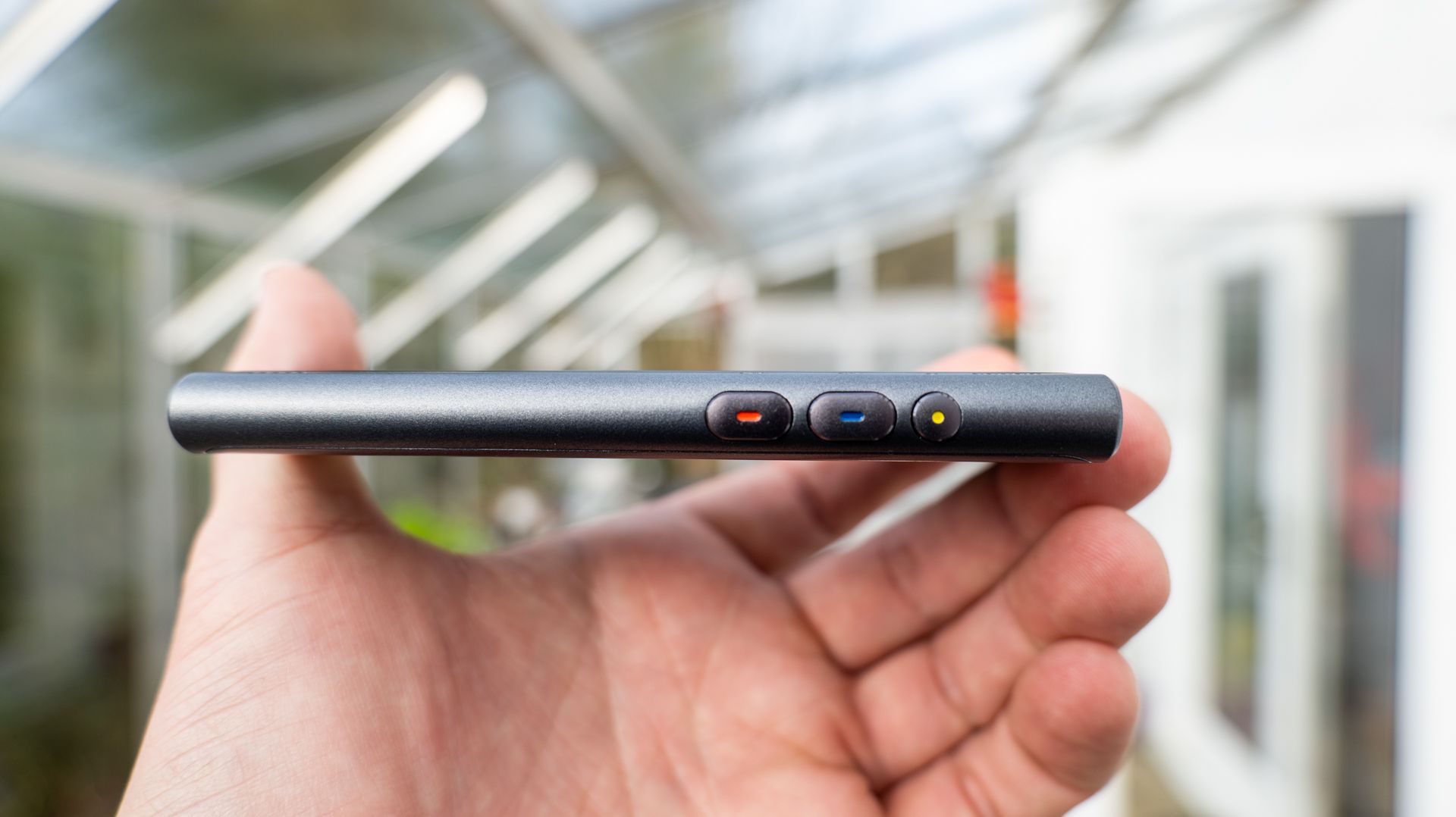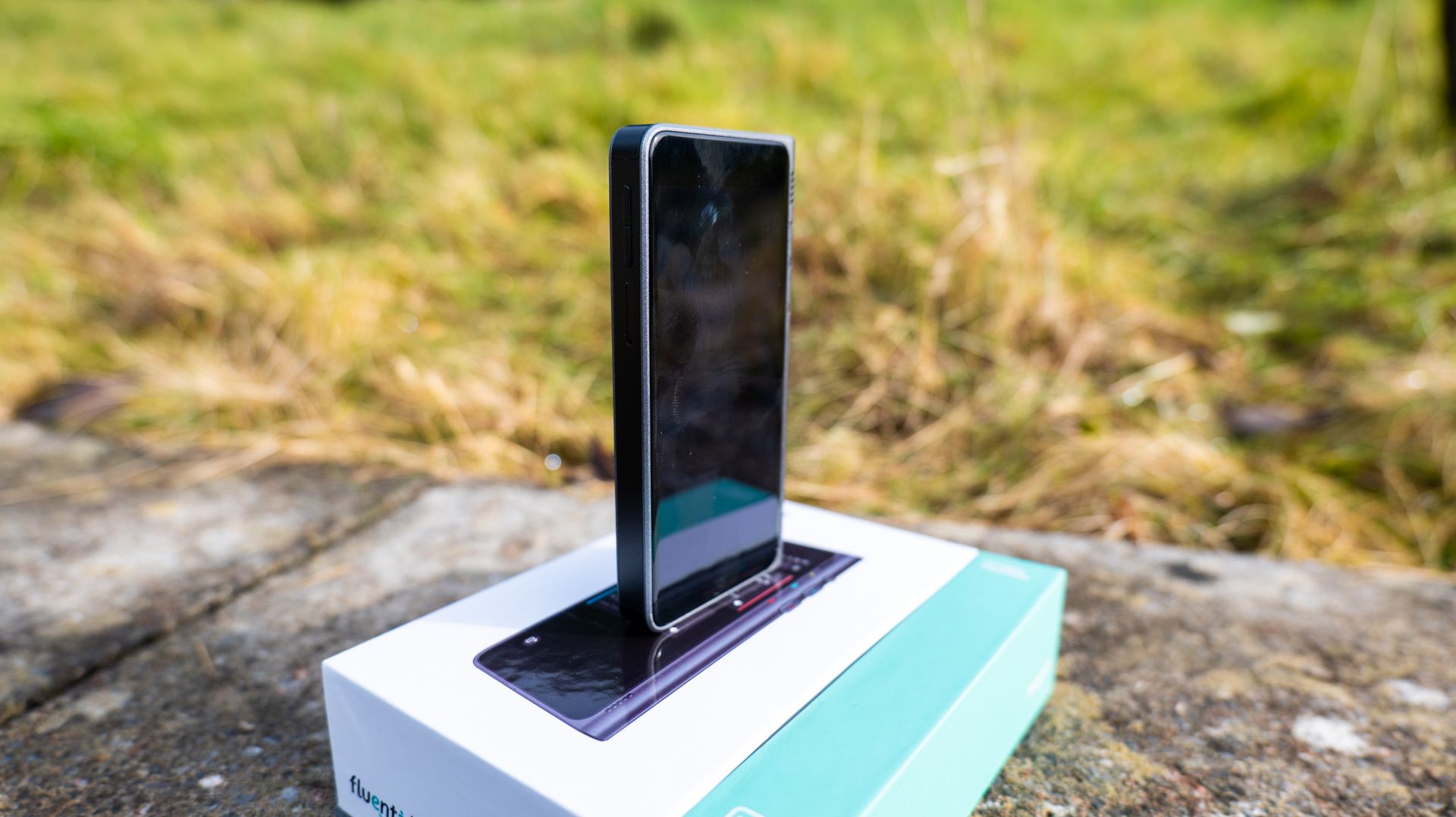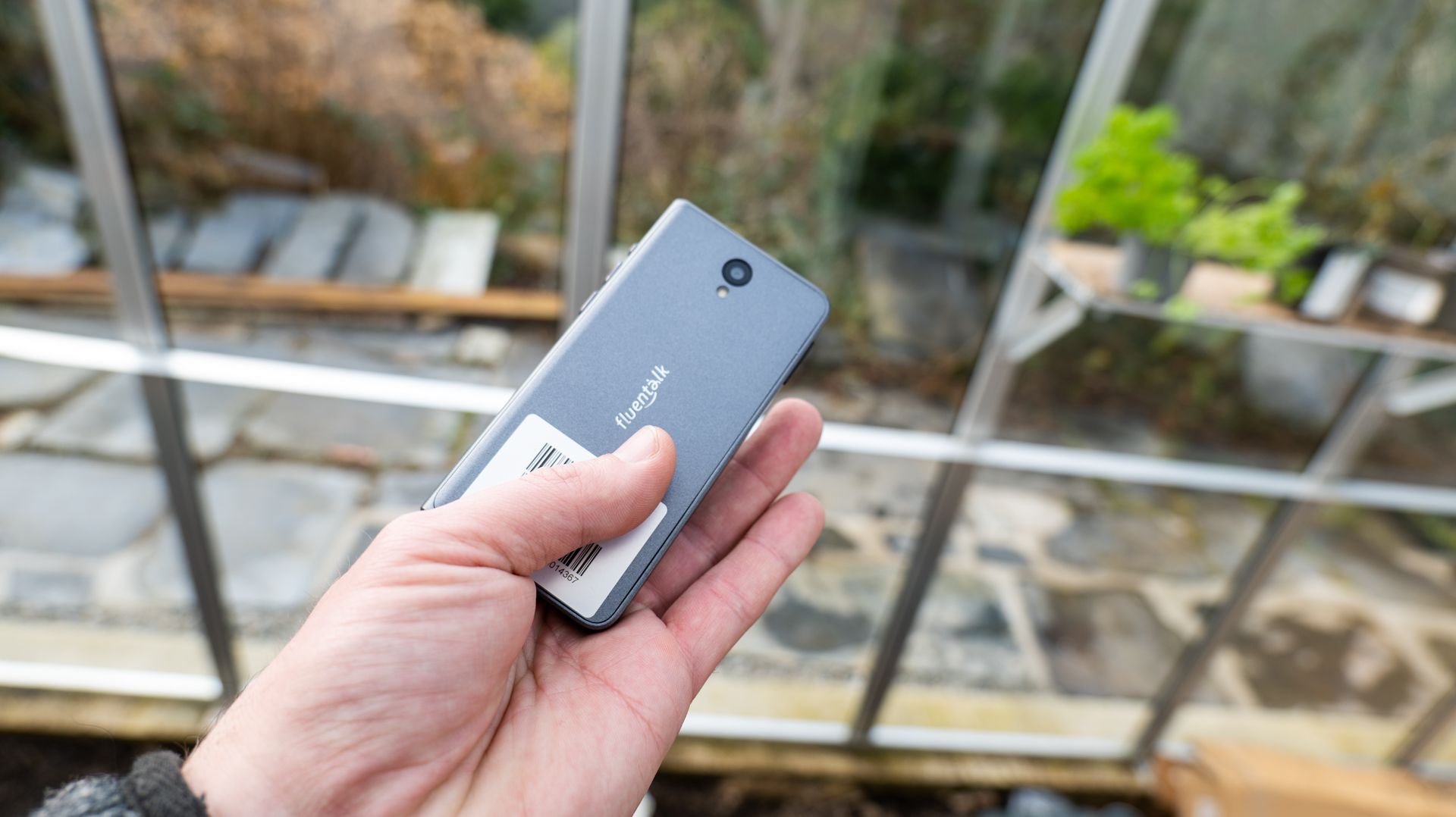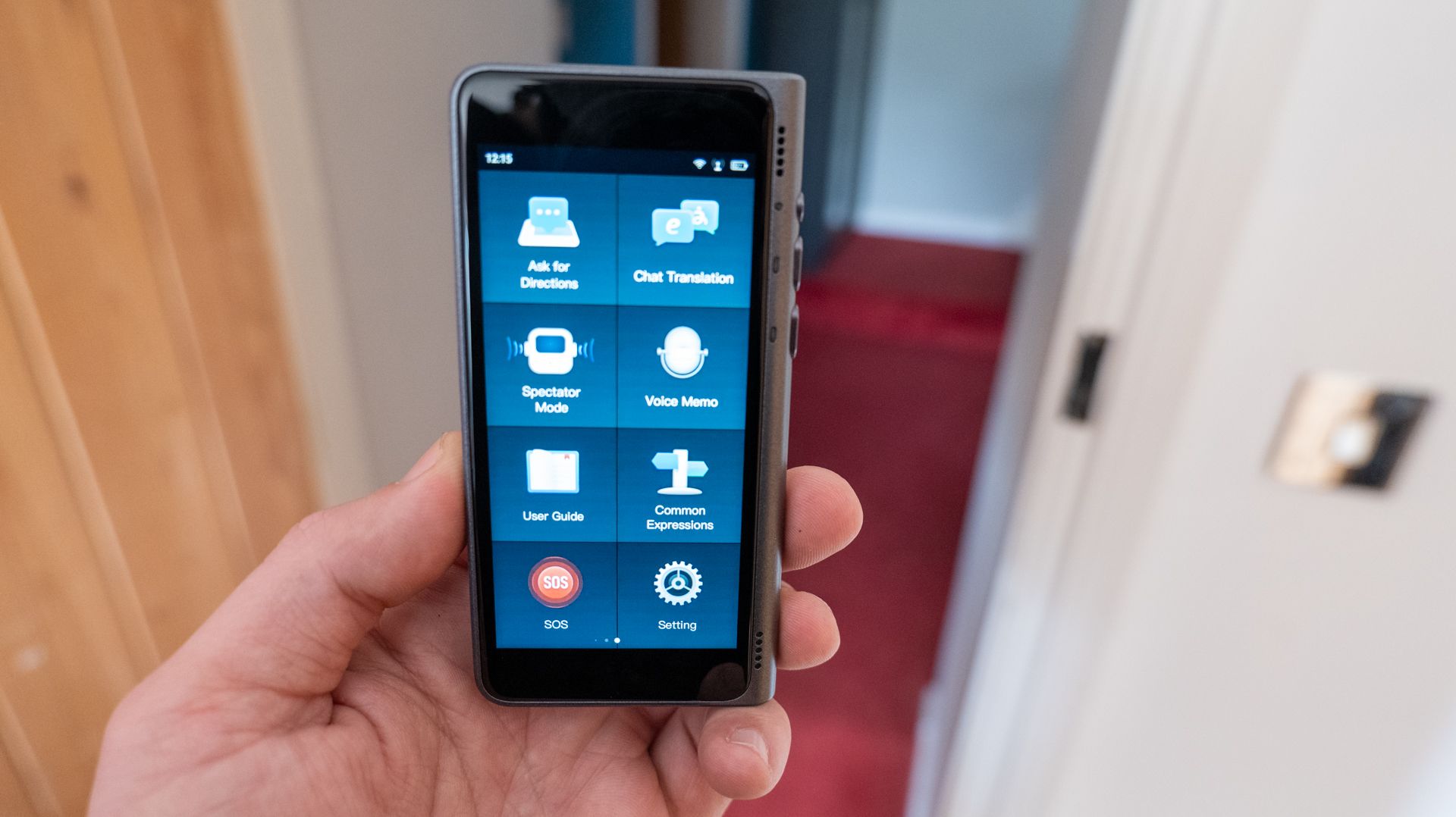Fluentalk T1
Even if your smartphone has a worldwide data plan, it's worth investing in a separate device just for translation for peace of mind. The Fluentalk T1 performed well in all our tests, and it feels like an essential device for frequent travelers. It features translation modes for every situation you might encounter, from conversations, listening to local news broadcasts or lectures, and even a built-in library of critical phrases.
- Brand: Timekettle
- Offline support: English and Chinese, to and from: Japanese, Korean, French, Spanish, Russian, and German
- Connectivity: Wi-Fi, Nanosim, eSim
- Languages supported: 40 languages, 76 dialects
- Two year worldwide data plan included
- Variety of modes to suit any situation
- Great for real conversations
- Performs well with dialects or tricky language
- Can ignore voices if there's background music or they're too high pitched
- There's a swear filter
The Fluentalk T1 from Timekettle is a pocket-sized translator with different modes to suit every situation you might find yourself in.
But is it an essential purchase for frequent travelers, and is it better than just using Google Translate on your smartphone? Let's find out.
If you haven't already, I'd strongly suggest watching the review video embedded above, as it's got real-world examples of the Fluentalk T1 in use, something which is very hard to convey in a text review.
Who is Timekettle?
Timekettle is no stranger to translation devices, having previously kickstarted and successfully delivered several earbud translators.
Despite the awe-inspiring nature of a real-life Babel fish, I've so far avoided the Timekettle earbud translators. In general, earbuds don't agree with me. By which I mean they thoroughly gross me out. From a features standpoint, while fine for one-way translation, any sort of bi-directional exchange will require you to either give one of the earbuds to someone else (even grosser)—or pull out an app for the other half of the conversation to use. In which case, you might as well just use an app in the first place. Read our previous review of the Timekettle WT2 Edge earbud translators.
The Fluentalk T1 is Timekettle's first device with an actual screen, and resembles a tiny smartphone.
However, this isn’t a Kickstarter with vague promises of features yet to materialize. It’s an actual product and you can buy it now.
What is the Fluentalk T1?
The Fluentalk T1 is a small Android-based device that ships with a two-year worldwide data plan. Translations can be done between 40 languages, including 93 dialects. Offline translation is also supported with eight different languages pairs: from English or Chinese, to Japanese, Korean, French, Spanish, Russian, and German. However, the base language must be English or Chinese—you cannot use say French to Russian offline (but you can still do that when online).
For this review, I've focussed on the use of Fluentalk T1 for Chinese and Japanese. Those are the languages I'm either most familiar with (having lived in Japan for seven years), or motivated by (having married a Chinese girl). I tried live news broadcasts, anime, as well as face to face interactions.
Design and Sepcifications
Measuring a mere 4.6 inches tall, 2.3 inches wide, and 0.44 inches thick (117 x 59 x 11mm), the Fluentalk is about half the size of your average smartphone. It's lightweight too, at just 115g (4oz).
Internally, it has 3GB of RAM, with 32GB storage, and runs a Quad-core CPU at up to 2GHz. There's a 4-inch 540 x 1080px screen that's just enough to display text comfortably. Wi-Fi, eSim, or NanoSIM options ensure you should be able to connect anywhere.
None of these specs matter though, other than to say it's basically low-end smartphone hardware, dedicated to the task of translation. While it uses Android 10 as the core OS, this isn't a generic Android device, and you can't install other apps on it.
A 1500mAh battery provides up to three and a half hours of continuous translation, while an 8MP camera also allows for visual text translation. You're probably familiar with this feature if you've ever used Google Translate, and it works in exactly the same way, so I won't dwell on that.
On the left side is a volume rocker and SIM tray, while on the right is a yellow power button, and a red and blue button, which correspond to on-screen instructions for which language is being translated. The device also features two microphones, on the top and bottom, which enable it to easily identify the language during chat mode.
Translation Modes
There are various modes and features on offer, so let’s look at the most useful.
One-Click Translation
Accessible from the Home Screen and probably the easiest way to use the T1 is one-click translation. Press the red button closest to you, to translate from your language to the other one. Press the blue button (closest to your partner) to translate back again. Simple. You just have to remember to press the buttons.
Both texts appear on-screen like a chat message, and you can scroll back through the history. This is also useful if you're a bit socially inept, and need time to think about what you're going to say beforehand. Just pre-record several phrases, then scroll up and select them to have the translation read aloud.
Hilariously, the device also allows you to translate from American English to real English, but it doesn't seem to do much. Unfortunately, a built-in list of “swear” words makes it impossible to decipher the mumblings of my coworkers from across the pond. Even more bizarrely, the swear filter is only active from English, and not in other languages. So we were able to get it to accurately translate certain Chinese or Japanese phrases back to English.
Ask for Directions
If you're terrible at following instructions and find yourself repeatedly needing to ask for directions, this mode allows you to preset a number of phrases, and select one to be shown in large type and read aloud. You can also quickly access this screen by double-tapping the power button.
Spectator Mode
Ideal for one-way listening to lectures or live broadcasts, spectator mode is a live translation feature that will continuously listen and silently translate on-screen. Once finished, you can also scroll back through what was said.
I tried this with a live Japanese news broadcast, and the results were great. If you watch the video, you'll see the translation is constantly updating. This isn't an error or bad performance from the Fluentalk T1. Japanese sentence structure is the opposite of English, so the most pertinent information tends to come at the end, changing the translation significantly as the sentence progresses.
I also tried with some anime, and the results were less impressive, with virtually no voices being picked up. Most of the time, light background music or sound effects were an issue (despite the speech being obvious to a human ear). In other cases, unnaturally high-pitched voices were ignored too.
I also left this mode running as my wife spoke to her father over WeChat in Chinese. While it picked up the gist of what she was saying (remember, this would very be conversational, sometimes out of context, short fragments of speech), the microphone struggled to hear what her dad was saying. We had to turn the volume up full and place the T1 right next to the iPhone speakers to get anything intelligible. Even then, it struggled with the harsh QingDao dialect.
Chat Mode
Most useful for traveling is perhaps the two-way conversation or chat mode. The device sits between you, with half the screen oriented toward you and another half upside down for your partner. With two microphones, the Fluentalk T1 can infer which language is which from the volume. Be sure to keep the device oriented correctly, or it won't work.
The chat mode constantly listens for both languages and translates as soon as a speaker pauses for a specified amount of time. You can adjust the pause time to allow for more natural speech (but potentially more errors if they hadn't finished the sentence yet), and disable the audio if desired.
The chat mode is ideally suited to a quiet setting with a new friend who understands the need to pause between sentences rather than trying to communicate with a shopkeeper or hotel staff.
Fluentalk T1 vs Google Translate
While the Fluentalk T1 performed admirably in my testing, both with local dialects, easy conversations, or listening to news broadcasts, some might be wondering if it performs any better than the free Google Translate app that you probably already have on your smartphone.
The answer would be: not really. Both performed roughly the same with any test sentences we tried. Both were equally as good as handling more conversational language or harder dialects. I found the Fluentalk T1 did slightly better with a live chat, but not enough difference to warrant a $300 purchase.
The Fluentalk T1 has the benefit of being a dedicated translation device with some key distinguishing features like easy access to a pre-recorded translation, but ultimately, no, it's not better than Google Translate. If you already have a worldwide data plan for your smartphone or offline language pairs downloaded, that would work just as well.
But that doesn't mean the Fluentalk T1 is superfluous or a waste of money. The two devices can certainly coexist. Why? At least for me, my smartphone is the single most important and valuable device I’ll ever carry when traveling. I don't want to walk around an unfamiliar place, waving a $1000 device around in plain sight to strangers as I go shopping and ask for directions.
While smartphones have grown in complexity and become essential parts of our modern life, people haven't changed. If a $300 translator is stolen, it's a nasty monetary loss, but it's certainly not the end of the world. If your smartphone is stolen in an unfamiliar place, well—that's your banking app exposed, probably a series of fraudulent tap-to-pay purchases you may end up liable for, and years' worth of family memories gone. It’s handy to have a device that does everything, but not always sensible.
An Essential Travel Companion?
As with all translation systems, you must think about and formulate your full sentence before you say it. In real life, we pause, we think for a moment, we stutter, we repeat ourselves, we skip words, and we miss out a lot of contextual information that will then be inferred by the listener. We’re a while away yet from being able to translate that kind of speech accurately, and I imagine AI will play a big part of that job in the future.
But given those current limitations, I've been impressed by what the Fluentalk T1 can actually do—at least with the language pairs we've tested. While not the equivalent of being fluent in another language, it gets across the gist of what’s being said more than sufficiently.
Given the generous included worldwide data plan, a three-and-a-half-hour continuous battery life, and offline translation if you really can’t get a signal, it’s a must for travelers or those who face any kind of language barrier in their daily life. It needs a clear and concise voice, so it works better in person than over a chat app, but if you have a decent microphone and speakers, that can also work.
There is, however, one massive downside to the Fluentalk T1: I no longer have an excuse not to talk to my mother-in-law.


